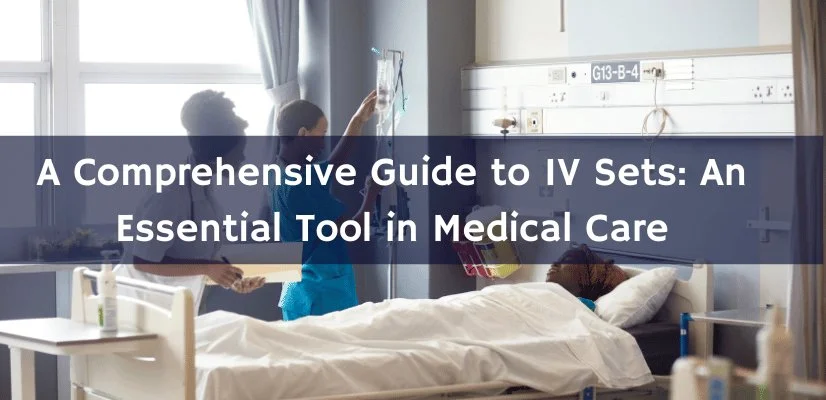Introduction (iv set)
In the field of medicine, the administration of intravenous (IV) therapy is an integral part of patient care. IV therapy involves the delivery of fluids, medications, and nutrients directly into the bloodstream, bypassing the digestive system. To facilitate this process, healthcare professionals rely on an essential tool known as an IV kit. In this comprehensive guide, we will explore the importance of IV kits, their components, usage, and maintenance.
I. Understanding IV Sets
IV sets, also known as infusion sets, are flexible plastic tubing systems designed to deliver fluids and medications intravenously. They consist of various components that work together to ensure the safe and effective administration of IV therapy. These components include:
- Spike or needle: The spike or needle punctures the container holding the IV fluid, enabling the flow of fluid into the tubing.
- Drip chamber: The drip chamber serves as a reservoir for the IV fluid, allowing healthcare professionals to monitor the flow rate and detect air bubbles.
- Flow regulator: The flow regulator manages the delivery rate of the IV fluid, guaranteeing a consistent and controlled infusion.
- Injection port: The injection port allows for the administration of additional medications or fluids without interrupting the primary infusion.
- Luer lock connector: The luer lock connector is a threaded connection that securely attaches the IV set to the catheter or cannula inserted into the patient’s vein.
II. Types of IV Sets
There are different types of IV kits available, each designed to meet specific medical requirements. Some commonly used IV sets include:
- Primary iv set: These sets are used for the primary infusion of fluids, such as saline solutions or medications, directly into the patient’s bloodstream.
- Secondary IV kits: Secondary sets are used when additional medications or fluids need to be administered alongside the primary infusion.
- Extension IV kits: Extension sets are shorter tubing systems used to extend the length of the IV line, facilitating easy movement of patients while maintaining a secure connection.
- Blood transfusion sets: Specifically designed blood transfusion sets to ensure the safe and efficient administration of blood and blood products.
III. Proper Usage and Administration
To ensure the safe and effective administration of IV therapy, healthcare professionals must adhere to certain guidelines:
- Sterility: To ensure the prevention of infections, it is crucial to maintain a sterile environment during the preparation and administration of IV sets. Proper hand hygiene and the use of sterile gloves, masks, and gowns are essential.
- Compatibility: It is essential to verify the compatibility of the IV fluid and medication with the selected IV set. Incompatibilities can lead to adverse reactions or reduced effectiveness of the treatment.
- Priming the IV set: Priming the IV set removes air from the tubing to prevent air embolisms. It involves filling the tubing with the IV fluid, ensuring there are no air bubbles present.
- Site selection and preparation: Selecting an appropriate vein for IV insertion and preparing the site with antiseptics help reduce the risk of infection.
- Monitoring and maintenance: Regular monitoring of the IV site, flow rate, and patient response is necessary to ensure proper functioning and prevent complications.
IV. Maintenance and Disposal
To maintain the integrity of IV sets and prevent contamination, you should follow proper maintenance and disposal practices.
- Changing IV kit: In a healthcare facility, the decision to change IV sets is determined by healthcare professionals based on protocols or changes in the medication or fluid being administered. Regularly changing the IV sets helps prevent blockages and maintain sterility.
- Storage: Store IV sets in a clean and dry environment, keeping them away from direct sunlight and extreme temperatures. Proper storage preserves the quality and sterility of the IV kits.
- Disposal: Used IV sets should be disposed of properly in accordance with medical waste management guidelines. This ensures the safe and environmentally friendly disposal of potentially hazardous materials.
Conclusion
Intravenous therapy plays a critical role in healthcare, and IV kits are indispensable tools for its successful implementation. Understanding the components, types, proper usage, and maintenance of IV kits is crucial for healthcare professionals to provide safe and effective care to patients. By adhering to established protocols and guidelines, healthcare providers can guarantee the precise intravenous delivery of fluids and medications, thereby minimizing the likelihood of complications and maximizing patient outcomes.
Remember, trained healthcare professionals under appropriate medical supervision must always perform the administration of IV therapy to ensure patient safety and optimize treatment efficacy.
Disclaimer
The information provided is for general knowledge only. Consult your doctor for personalized advice and treatment. Medikart HealthCare is not liable for any actions taken based on this info.

